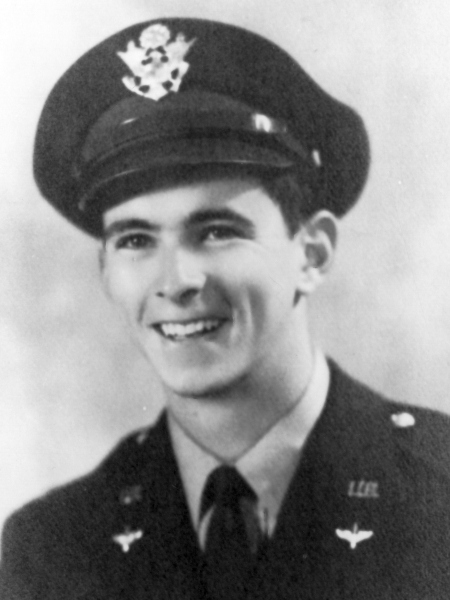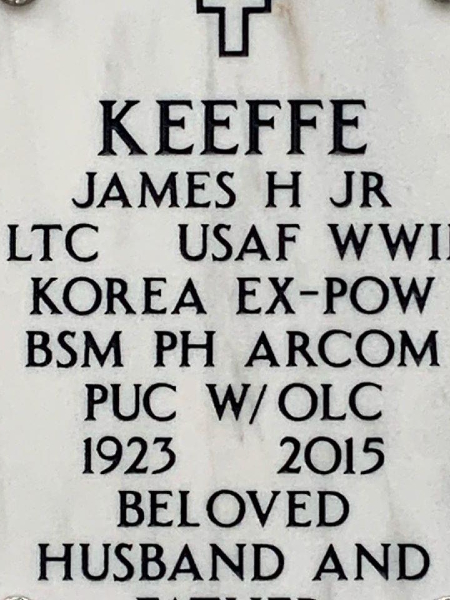Keeffe, James H.
- Date of birth:
- March 12th, 1923 (Sioux City/Iowa, United States)
- Date of death:
- May 26th, 2015 (White Horse/Yukon, Canada)
- Service number:
- R 157721
- Nationality:
- American
Biography
James H. Keefe Jr. volunteered to join the US Army Air Force in the summer of 1942. It was his wish to become a fighter pilot, but after training on various aircraft, he began training to fly heavy bombers, in his case the B-24 Liberator, in July 1943. He arrived in England on Thanksgiving Day 1943 (25 November). After a short stay at Cheddington, he was posted to the 366th Squadron of the 389th Bomb Group at Hethel Airfield near Norwich and the war began for him.
He flew his first mission on 21 February 1944 as co-pilot on a B-24 during the so-called ‘big week’ which aimed to inflict as much damage as possible on the Luftwaffe and the German aircraft industry. This mission went rather easily, the original target near Braunschweig could not be reached due to bad weather and the bombs were dropped at an airfield near Diepholz near the Dutch border. This was followed by a tough mission over Gotha where one counted more than 300 bullet holes in the plane and a target in southern France.
His fourth and, as it turned out, last mission was to target a ball bearing factory in Berlin, far into enemy territory and which was heavily defended. Over Germany, engine 3 caught fire and, after dropping bombs on an occasional target, attempted to rejoin the formation. When, after an attack by a German FW-190 fighter, engine 2 also failed, the crippled plane had to make its way back to England in solitude. Over the Netherlands, it became clear that this would not succeed. Fuel ran out and the crew, one of whom had already died by now and two others were injured, decided to abandon the plane.
Over the Alblasserwaard, the wounded were thrown from the bomb hatch by their parachutes and the seven others including James Keeffe also made the jump. They landed, wounded or not, and scattered over the Alblasserwaard and Dordrecht where they were all -except James Keeffe- captured. Execpt for Seageant Miller all survived the war. The plane grounded in Hendrik Ido Ambacht off Vrouw Geelenweg, flying on autopilot. The deceased crew member Sergeant Miller was buried in Hendrik Ido Ambacht cemetery and later reburied at the Fort Snelling National Cemetery in Minneapolis.
James Keeffe ended up in a tree in Papendrecht and hid in a barn. There he was found by the owner of the barn who alerted the local resistance. That same night, he was taken across the river in a rowing boat, en route to his first hiding address in Dordrecht. This was the beginning of a series of hideouts that took him to Rotterdam, and later Antwerp. It was now July 1944 and from there he would try to reach Allied territory. There was treachery, however, and on 26 July 1944 Keefe was arrested by the Gestapo.
After being handed over to the Luftwaffe, the journey began past several prisoner-of-war camps in Germany before finally being liberated in Stalag VII B at the end of April.
After the war, after a brief career in civil aviation, Keeffe returned to the US Air Force, eventually retiring there as a lieutenant colonel in 1966. He visited the Netherlands several times and kept in touch with the people and their relatives who had helped him in the Netherlands at the time.
Several of his helpers, Albert Jappe-Alberts, Johannes Berlijn and Leendert Marinus Valstar had to pay their illegal work with death and were executed by the Germans.
James Keeffe told his story in detail in 2002 to his son James H. Keeffe III, who published it in the US under the name ‘Two Gold Coins and a Prayer’. The book won several awards and was released in the Netherlands in 2024 as ‘Liberator Down’.
Do you have more information about this person? Inform us!
Sources
- Photo 1: Peter-Jan van der Giessen
- Photo 2: Peter-Jan van der Giessen
- - BARZILAIJ, W., Cocky, Boekerij, Amsterdam, 2020.
- JAMES H. KEEFFE III, Liberator Down, Stichting James H. Keeffe, Papendrecht, 2024.
- James Keeffe at his arrest in antwerp.
- James Keeffe after his liberation.
- Picture B24 Crew.
- James Keeffe at his hidding place.
- On board B24.



